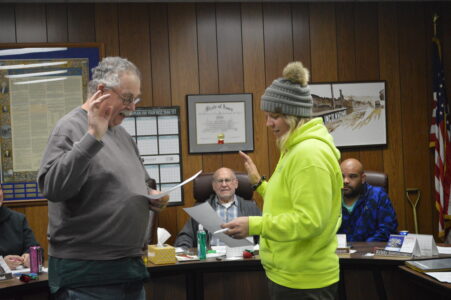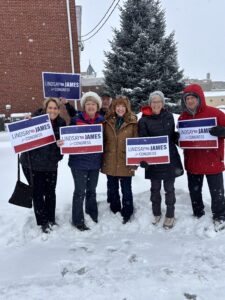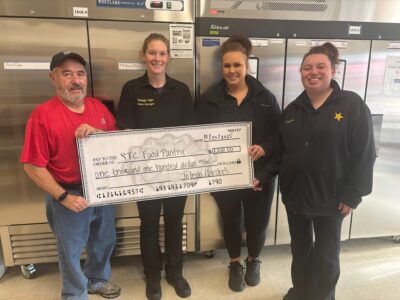‘We were welcomed here for a long time’
Ahead of Monday’s defining vote, Salt Creek Wind owner, developers and leaseholders address opposition
- Sean Roberts, CEO of Nations Energy Solutions and the owner of Salt Creek Wind Phase II, pictured on Wednesday, Sept. 10, at his office in downtown Toledo. PHOTO BY RUBY F. MCALLISTER
- A newly-constructed Salt Creek Wind Phase I wind turbine pictured on Sept. 10 near NextEra Energy Resource’s laydown yard located at the intersection of US 63 and 220th Street southwest of Traer. PHOTO BY RUBY F. MCALLISTER
- PHOTO BY RUBY F. MCALLISTER
- PHOTO BY RUBY F. MCALLISTER
- A ‘Freedom to Farm Wind’ sign located along US 63 in the footprint of Salt Creek Wind Phase I. PHOTO BY RUBY F. MCALLISTER
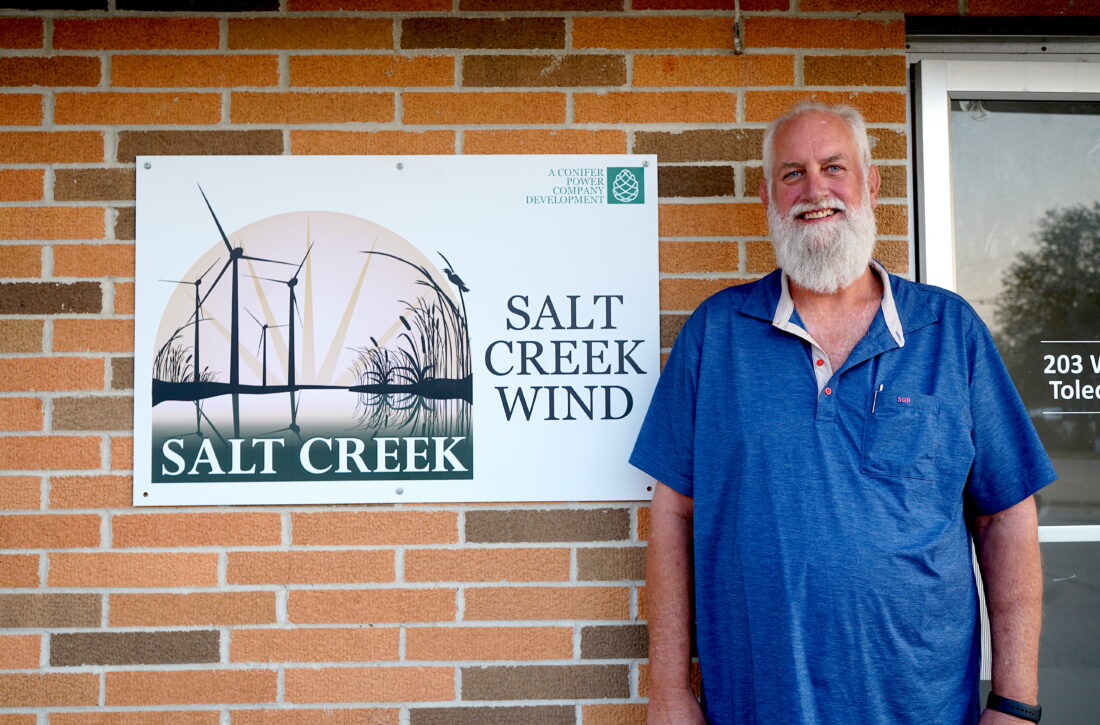
Sean Roberts, CEO of Nations Energy Solutions and the owner of Salt Creek Wind Phase II, pictured on Wednesday, Sept. 10, at his office in downtown Toledo. PHOTO BY RUBY F. MCALLISTER
Editor’s Note: This story is publishing online ahead of the Friday, Sept. 19 print edition in advance of tomorrow’s (Monday, Sept. 15) Tama County Board of Supervisors meeting.
TOLEDO – In roughly 12 hours time, the future of Salt Creek Wind Phase II – the second and final phase of the roughly $418 million Salt Creek Wind Project in Tama County – will more than likely be decided by the Board of Supervisors as part of a settlement agreement with the project’s owner.
But while most county residents are familiar with Salt Creek Wind following years of newspaper headlines, grassroots oppositional organizing, political rhetoric, lawsuits, and local government action surrounding the project’s development, very few folks are familiar with the project’s owner, Florida resident Sean Roberts, CEO of Nations Energy Solutions. Roberts acquired Salt Creek Wind from Wind Capital Group (an arm of the Irish renewable energy company NTR) roughly a decade ago. Last fall, he sold Salt Creek I to NextEra Energy Resources and is currently developing Salt Creek II. Both phases were originally intended as one cohesive project but were split due to the need to hook into two different substations. Salt Creek Wind II is a 100 megawatt project located solely in the South Tama County Community School District’s geographic boundaries. Upon completion, the project will include anywhere from 24 to 27 turbines, depending on which model is selected.
In anticipation of Monday’s vote by the supervisors, Roberts along with Bob Bergstrom of Conifer Power Company and a small group of Salt Creek Wind leaseholders sat down with the newspaper last Wednesday in the project’s Toledo office for a wide-ranging discussion. (Bergstrom’s company has been on the ground assisting with the development of Salt Creek Wind since the project was owned by Wind Capital Group.)
One of the first questions the newspaper asked Roberts was if he ever expected such fierce grassroots opposition to his project – opposition spearheaded by the local coalition Tama County Against Turbines (TCAT) which formed in 2022.
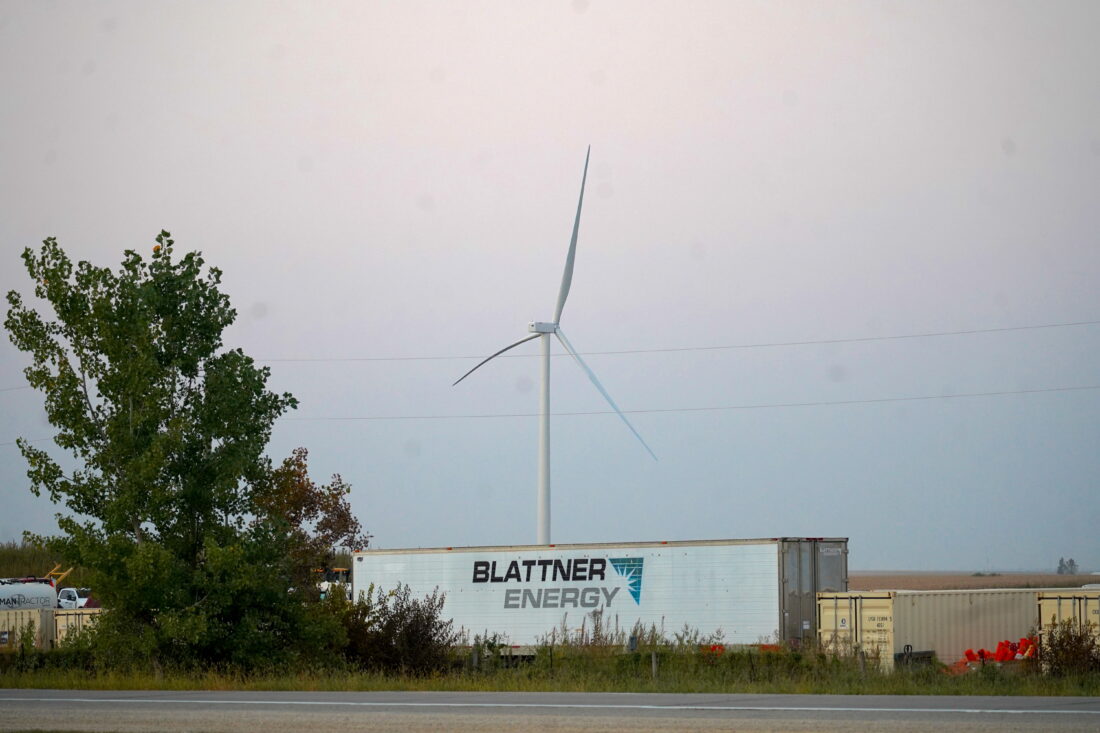
A newly-constructed Salt Creek Wind Phase I wind turbine pictured on Sept. 10 near NextEra Energy Resource's laydown yard located at the intersection of US 63 and 220th Street southwest of Traer. PHOTO BY RUBY F. MCALLISTER
“No,” Roberts succinctly responded as he sat near the corner of a large conference room table. To his right, Salt Creek Wind leaseholder Kurt ‘Doc” Boerm was seated beside him, while across the table, leaseholder Craig Sash faced him.
“And I will tell you this,” Roberts quickly added, “the biggest complaint we used to have was the adjacent landowners [asking], ‘Why didn’t you put turbines on my land?’ Or the landowners that we were putting turbines on [asking], ‘Why didn’t you put more?’ That used to be the biggest complaint we had. But that’s not what’s going on here.”
Roberts, who has been a bit of an enigma in Tama County over the last 10-11 years, is an extremely affable individual upon first meeting. His bushy white beard (he’s been told his big brother must be Santa Claus) combined with a drawn-out Mississippi drawl (acquired in childhood) and somewhat rumpled, casual attire skews more blue collar than the typical CEO stereotype. According to his resume, which was provided to the newspaper, Roberts began his career in 1975 as a flight test support technician in Mojave, Calif., where he performed aircraft maintenance, installed and operated test instrumentation, and coordinated with other technical support staff. He moved into the wind energy sector some 10 years later and seemingly never looked back.
When asked if he’s encountered oppositional energy to his projects elsewhere – opposition similar to TCAT – he said no.
“We’ve been lucky. We’ve had some small groups but nothing like this one,” he replied.
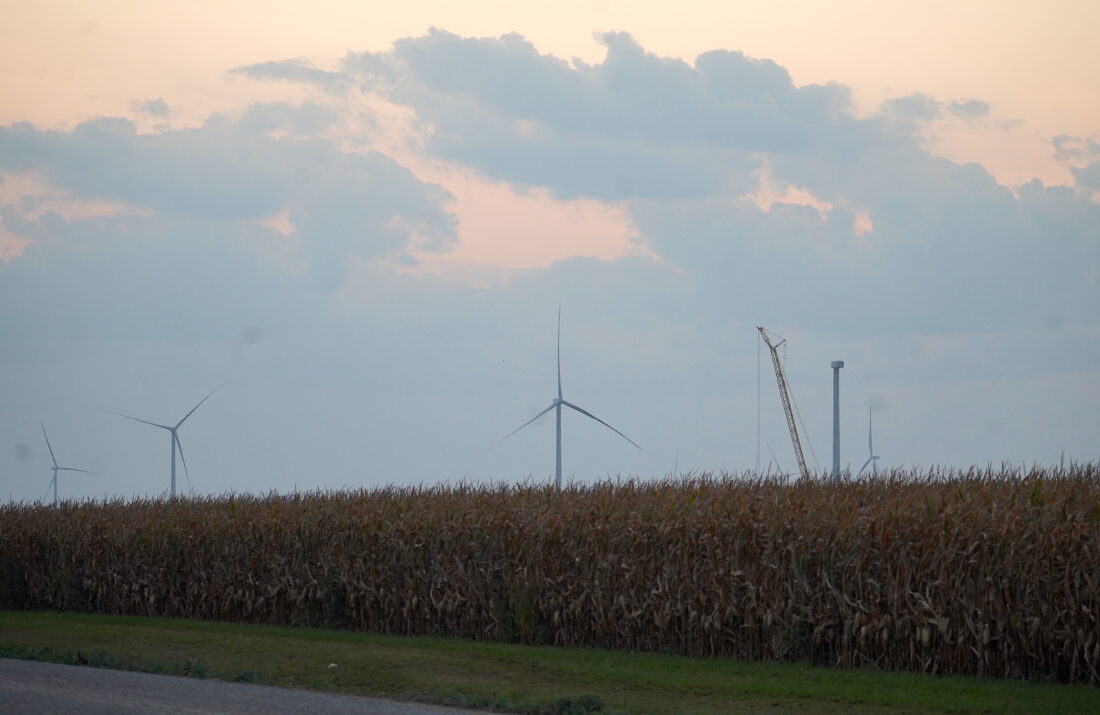
PHOTO BY RUBY F. MCALLISTER
“Generally speaking, you reach out to that group and you talk with them and they’ll meet with you,” Bergstrom further explained. “[TCAT] would not meet with us. And usually when you sit down – it’s hard to hate somebody when you’re sitting across the table from them and you see they’ve got a wife and family and all that. And we’re not bad people. And [this project] is not evil.”
Roberts added that such local opposition usually means a project is never developed in the first place.
“If we go into an area that we think is real hostile, we just leave. Why would we even invest money into it?”
“We didn’t hear a word from [TCAT] for two years after we had our permit,” Bergstrom said in reference to the conditional use permit (CUP) Salt Creek Wind was granted in December 2020.
“And from 2009, when this whole thing started,” Doc Boerm added. “There was not a word.”
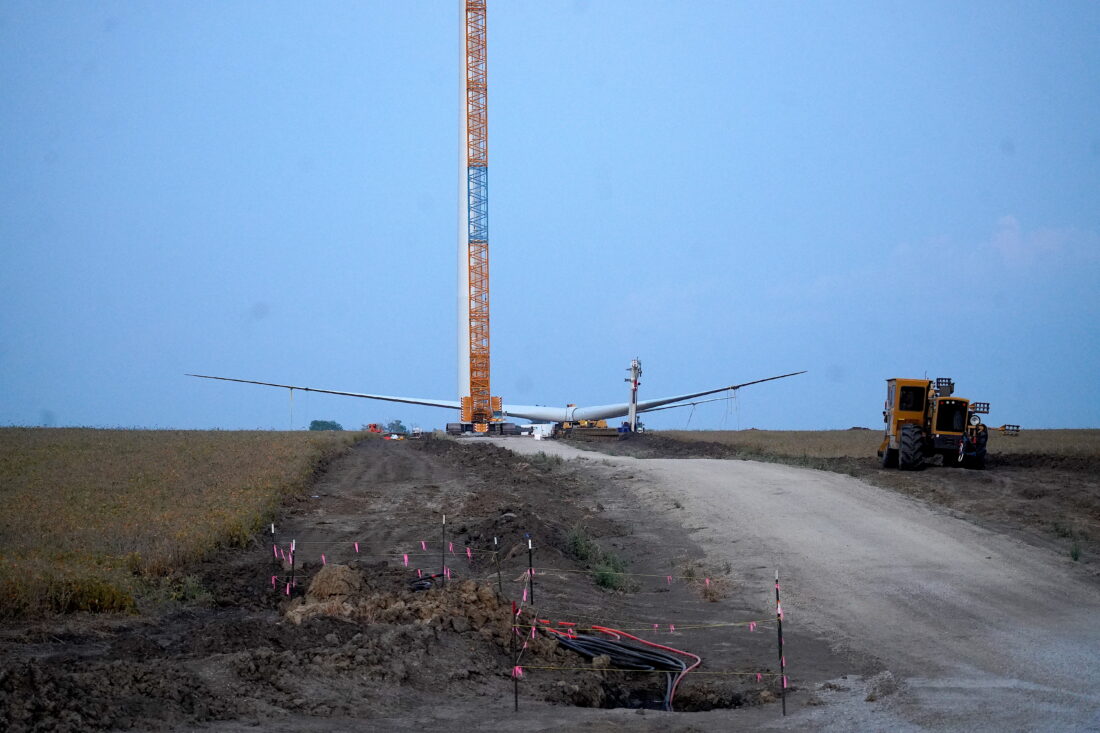
PHOTO BY RUBY F. MCALLISTER
“They didn’t raise their heads until Apex came through,” Bergstrom said, naming the now-defunct Winding Stair Wind Project in development in northeast Tama County by Apex Clean Energy from roughly late 2021 through early 2024 before the company – wholly unrelated to Salt Creek Wind – pulled the plug due to insufficient leased land.
“When I started doing this, I’ve always [said], we’re purple – we’re neither blue nor red, we’re purple,” Bergstrom began in response to a question asking why opposition to commercial wind energy development – both in Tama County and throughout rural America – seems to have hit a fever pitch. “I don’t do politics. I mean, I really don’t. Because you can’t [be political coming] into a local area.” He then listed off the many, many states in which he has helped develop commercial wind energy projects from North Dakota to Oklahoma to New Mexico. The local response, generally, he said, was always appreciative before the winds began to figuratively shift. In a recent Politico article, President Donald Trump was quoted stating during a Cabinet meeting, “We’re not allowing any windmills to go up. They’re ruining our country.”
“The problem that I see, there’s so much misinformation out there,” Roberts said. “I’ll give you a perfect example. People say it’s the ‘Green New Scam.’ But think about this, [in] Iowa, 60% of the [energy] generation is from wind. … And Iowa is the fourth cheapest state for electricity.”
“Wind turbines are the second cheapest form of energy,” Doc Boerm added.
“[Wind energy] is extraordinarily predictable,” Bergstrom said. “It’s extraordinarily reliable that way.”
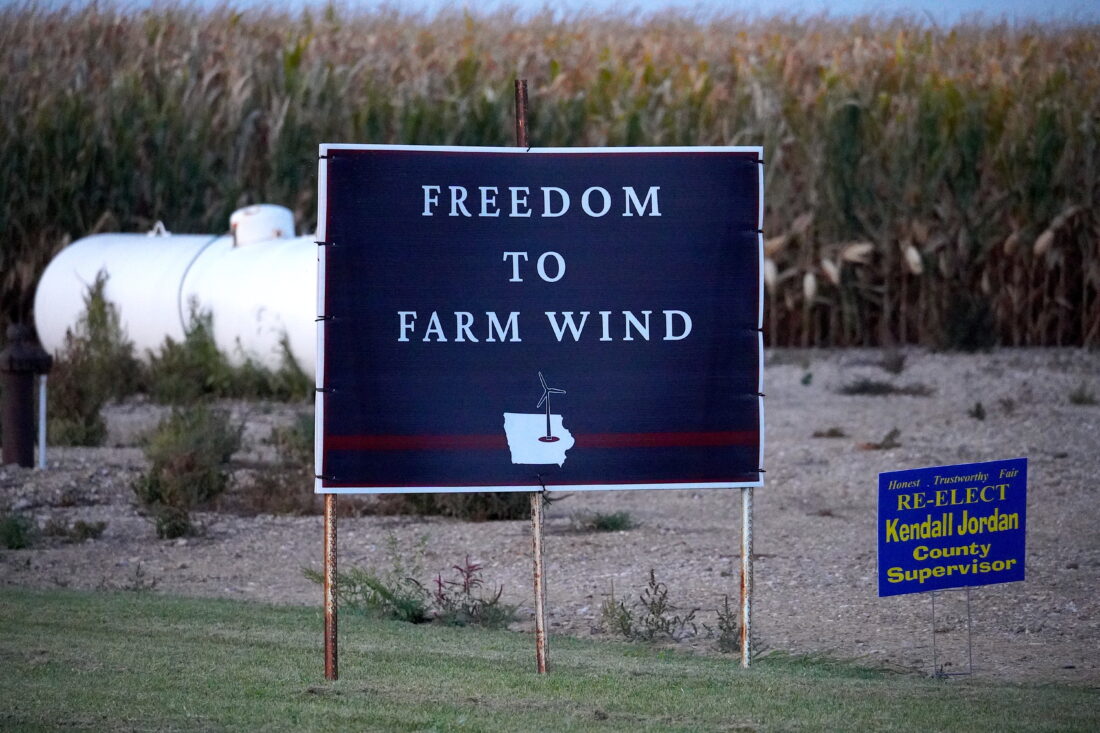
A 'Freedom to Farm Wind' sign located along US 63 in the footprint of Salt Creek Wind Phase I. PHOTO BY RUBY F. MCALLISTER
“The blades aren’t on the ground. They’re 500 feet in the air, and the wind’s always blowing up there,” Doc Boerm said in reference to those who criticize wind energy for being unreliable due to the fluctuating nature of wind. “I’ve lived up there in that area [near Vienna Wind Farm] and very few days in the last 10 years can I remember where it was so calm in the summertime that the [turbines] were just standing.”
‘Subsidies’
“First off, it’s not a subsidy, it’s a tax credit,” Bergstrom said when asked to address the argument that commercial wind energy projects wouldn’t exist without federal help. “There’s nothing illegal or immoral or unethical about [tax credits].”
“Wind is still the cheapest when you take out all the subsidies,” Doc Boerm said.
When asked about President Trump’s recent Executive Order directing the Secretary of the Treasury to end certain credits for wind and solar, both Roberts and Bergstrom fervently denied such a move would end wind’s heyday.
“In the 1990s we went seven years without tax credits,” Roberts replied.
“The biggest boon to the wind industry was [President] George [H.W.] Bush and then Senator [Chuck] Grassley, and then [Governor] George [W.] Bush in Texas when he did the renewable energy standard,” Bergstrom said, referencing legislation then-governor George W. Bush signed in 1999 that both deregulated the electricity market – encouraging growth in renewables – and set an initial renewable energy goal of 2,000 megawatts.
“We’ve gotten more out of the red side – even though we’re purple – than we ever got out of the blue. … I’ve seen it come and I’ve seen it go. America needs more energy all the time,” Bergstrom continued before later addressing coal.
“I’ve been around coal all of my life and no one is going to revive that and bring back that industry. It’s not because we’re saving Mother Earth – [coal is] more expensive. … It’s sheer economics.”
In terms of the “hedge” wind turbines provide to both farmers and landowners, the certainty lease payments provide is nearly unmatched.
“That’s the reason farmers and ranchers love us – is because we’ve given them a 30-year – with two 10-year extensions – [certainty]. And they know exactly how much [the payments will be] every year,” Roberts said.
“It follows an escalator with inflation,” Doc Boerm added.
Leaseholders want out
Roberts also addressed the argument that Salt Creek Wind leaseholders want out of their signed leases – the answer, in simple terms, is the vast majority of leaseholders “are in,” Roberts said.
Both Doc Boerm and Craig Sash confirmed with the newspaper that, as leaseholders, they met in person with Salt Creek Wind developers and engineers – several times, in some cases – in regard to the placement of turbines on their land.
“They brought us in here and said, ‘OK, we think we’d like to put one here, is there a reason that you would not want one there?'” Doc Boerm explained. “We talked about roads – I mentioned one place that I just [preferred] they not put a road. They moved the road. For me.”
“I think they moved the whole turbine for me,” Sash added. “The road went down and jagged over. [I said,] ‘Let’s move [the turbine] 100-foot this way, if we can, and keep a straight road.'”
“And I wanted the road east-west,” Doc Boerm said, in response to Sash’s anecdote. “Don’t bring it in from the north and south because I plant this farm east-west.”
“As long as you have reasonable questions or reasonable asks, they were fantastic,” Sash said of Salt Creek Wind.
Under the cover of COVID
Another accusation that has been lodged against Salt Creek Wind’s developers over the past three years is that the project – for which the first CUP application was approved 4-0 in December of 2020 by the Tama County Board of Adjustment – was developed partially through the cover of the pandemic.
For example, Trish Jesina, of rural Toledo, told the newspaper in January of 2021: “I feel that the only people who were made known about the project were the ones that would benefit from it. The acreage owners and the landowners who did not sign up were left in the dark. Salt Creek Wind used this along with the pandemic to their advantage to get this passed without letting the public know.”
“We’ve been here for 11 years,” Roberts said in response to the accusation.
“I was up here, our crew was up here. We [followed] the [COVID-19] guidelines that [Governor Kim] Reynolds had out at that time. And we didn’t do it with FedEx. We didn’t do it long distance. We did it in-person, upfront, because most of the people here want to deal that way. And two of my guys got COVID – one of them was 73 years old. So if they want to say we rammed it through, so we could do it in the dark of night – we did not. … It was all public-noticed. It wasn’t until Apex came … that it got out of control,” Bergstrom said.
Property rights
The newspaper read aloud to both Roberts and Bergstrom several sections of a recent editorial published in all three of Tama-Grundy Publishing’s print editions, asking for their thoughts. The column – titled “A resentment as old as America itself” and written by Kayla Gabehart, an assistant professor of environmental policy at Michigan Technological University – addressed the “sentiment of rural people being left behind, left out and snubbed by their urban counterparts” in an “ever-urbanizing, globalized world.”
“Rural communities take the position that they’ve been made to bear the brunt of the transformations of the global economy for generations, including those that deal with energy and the environment,” Gabehart wrote, in part.
After pausing for several moments to gather his thoughts, Roberts calmly and thoughtfully responded.
“I’m a big personal property rights person. My dad taught that to me growing up: personal property is very important. So I have a lot of respect for people that want to protect their property and want to do things with their property. So it goes both ways. And it’s a fine line that you got to work through.”
“So the people that don’t want [a wind turbine lease] – they say no, we don’t put it on [their land]. … All the leases we have are volunteer. … We don’t like being in places we’re not welcome. And we were welcomed here for a long time. And so we invested a lot of money here because we thought that we were welcomed.”
“I don’t think the majority cares,” Sash said when the discussion turned to the current Tama County response to Salt Creek Wind. “It’s indifferent to them.”
“We can go toe-to-toe with every single issue that TCAT or any other opposition group [lobs at us] …. and win except one – how they look,” Bergstrom said. “If you can see them, then they’re bad, in some people’s opinion. But all the rest of it, they lose. … We’re making power that’s going to be used. It is a business and it’s a good one. … I’ve never been around this many people who think they have that much control over somebody else’s property and won’t let go of it.”
Tama County: ‘Closed for business’
One of the final questions the newspaper posed to Roberts was would he have invested in Tama County all those years ago if he had foreseen the trouble ahead.
“I’ve met some great landowners and some great people,” Roberts responded. “I’ve been coming up here for 11 years, off and on. Doc, I remember meeting you a long time ago.”
“You rode in my combine,” Doc Boerm replied with a smile before later explaining he did not realize at the time who Roberts even was, he was so disarming.
“If we’d known there was a big anti-wind group here at the very beginning, we probably would have just passed. But after we got in here and got to meet everybody, and the team was so positive about this area. If I had to do it all over again, I would do it all over again,” Roberts said.
While Bergstrom agreed with Roberts, he did add a disclaimer, alluding to Tama County’s still-intact commercial wind energy conversion system moratorium.
“Tama County has a ‘Closed for Business’ sign out [now]. The reputation that you’re going to get, with the types of ordinances you’re passing … any business, who’s going to invest cash [now]? … This is serious stuff. … Property rights [for farmers] mean a lot. This is their business. It’s not a Grant Wood painting. … If you want to know what rural economic development looks like, it’s wind and solar because the counties have to put up nothing. There’s no money that the county [puts up] here. Nothing. It’s huge. … We come self-contained, roll it out, and here’s your check.”
“And we have to maintain the roads for the life of the lease,” Roberts added.
A way to heal
If the vote on Monday goes Salt Creek Wind’s way – the road ahead cleared, figuratively and literally, for Phase II – Bergstrom suggested the county convene a group to determine where best to invest the millions in revenue Tama County will receive over the life of the project.
“I would put a blue ribbon panel together and perhaps [include] some of the TCAT people … They need to figure out what they’re going to do with the money and they need to have [local] input. Benchmark good and bad against all the other counties that have them. Call up their county supervisors.”
A windfall of revenue
If approved, Roberts said Salt Creek Wind Phase II should begin construction next summer. As of Wednesday, Sept. 10, 14 turbines had been completed as part of Phase I, per Doc Boerm.
According to an economic impact analysis commissioned by Salt Creek Wind and issued in November 2023 by Strategic Economic Research, LLC, the total property taxes paid by the entire project – Phase I and Phase II combined – over its 30-year lifetime are conservatively estimated at more than $80.9 million, averaging some $2.6 million annually after starting at $0 due to Iowa’s special valuation for wind energy conversion property before increasing steadily until the year 2032.
In addition to an increase in tax revenue, the project’s property tax base will also significantly increase the borrowing power of four local school districts including GMG, South Tama County, North Tama County, and Gladbrook-Reinbeck.
On Monday, Sept. 15, the Tama County Board of Supervisors is expected to take action on several agenda items related to the Salt Creek Wind Phase II including the following:
-Approve decommissioning plan with SCW 2
-Approve Settlement Agreement with SCW 2
-Approve road use agreement with SCW 2
As the newspaper’s time with Roberts, Bergstrom, and the leaseholders came to a close last Wednesday, Roberts ventured outside Salt Creek Wind’s Toledo office to stretch his legs. With the sun beginning to dip toward the horizon, he was asked what his plans were for the upcoming weekend. He said he thought he would head up to Clear Lake, Iowa, where the Cerro Gordo Wind Farm is located, a project he built many years ago and is now owned by NextEra Energy.
“We had good luck [in Iowa] until just a few years ago,” Roberts commented. “I was going to go up there and just check on some people, see if I can find some of the landowners. … I’ve built over 4,000 turbines in this country. I try to – if I’m in that area – check on people.”
“We’re going to be here for 30 to 50 years, we want to be good neighbors.”




